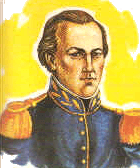Juan Domingo de Monteverde facts for kids
Juan Domingo de Monteverde (born April 2, 1773 – died September 15, 1832) was a Spanish soldier. He became the Captain General of Venezuela from June 1812 to August 1813. Monteverde led the Spanish forces during the Venezuelan War of Independence.
He was in charge of the military campaign that caused the First Republic of Venezuela to fall in 1812. However, in 1813, Monteverde was defeated by Simón Bolívar during a major campaign called the Admirable Campaign.
Contents
Early Life and Arrival in Venezuela
Monteverde was born in the Canary Islands in a town called San Cristóbal de La Laguna. This was on April 2, 1773. He was a respected Frigate Captain in the Spanish Navy.
In early March 1812, he was sent to Venezuela from Puerto Rico. He arrived in Coro with a small group of Spanish marines. The governor of Coro ordered Monteverde to help the town of Siquisique. This town wanted to leave the Republic and join the royalist side.
Monteverde had a small force of about 1,550 men. They were not fully prepared for a big military campaign. Spain was fighting its own war against Napoleon's forces in Europe. This meant there were not many resources to send to the New World.
Gaining Support and Advancing
Monteverde's mission was helped by many people in Venezuela who were unhappy with their new rulers. After a seven-day march, he reached Siquisique on March 17. He found it easy to get new soldiers from the local people.
With more and more people joining him, Monteverde decided to keep moving into republican land. He did this even though he didn't have official permission. His success was boosted because many lower-class people supported him. They saw the wealthy republican leaders as their enemies.
Monteverde built an army that included people from different backgrounds. These included pardos, zambos, and people from the Canary Islands. Even some middle and upper-class people joined his cause.
Many city leaders welcomed his army. Some wealthy mantuanos (aristocrats) even worked with him. A big earthquake on March 26, 1812, also helped his cause. Many people saw it as a sign that God was against the Republic.
Key Victories and the Fall of the First Republic
On April 2, Monteverde's leading troops entered Barquisimeto. The city had already switched to the royalist side on March 31. Soon, he had a large enough army to march on Valencia. This city had seen a royalist uprising the year before.
After winning a battle against republican troops on May 3, he was welcomed into Valencia. His next goal was Caracas. In June, Monteverde reached areas near La Victoria and San Mateo. He was pushed back in the 1812 Battle of San Mateo.
However, things changed when Puerto Cabello was lost on June 30. Royalist prisoners took over San Felipe Fort. This was a big blow to the republican side. Generalissimo Francisco de Miranda was forced to retreat. There was also a rebellion in Caracas against the republican government.
Monteverde's advance led to an agreement with Miranda on July 25, 1812. This agreement, called a capitulation, happened after the Battle of San Mateo. Miranda never signed the final paper, but his representatives had approved it.
Later Campaigns and Defeat
After the First Republic fell, Miranda was captured and sent to Puerto Rico. Most patriot officials chose to go into exile, which was allowed by the agreement.
In 1813, Santiago Mariño invaded Venezuela from the east. He successfully captured the port of Güiria. He also took the city of Maturín, which Monteverde tried but failed to recapture.
At the same time, Simón Bolívar began his Admirable Campaign. He entered Venezuela through the Andes mountains. Monteverde was worried about Bolívar's presence. He set up his main forces in Valencia. This location was important because paths from Barinas, the Andes, and Maracaibo met there.
Monteverde's forces were positioned similarly to Miranda's in 1812. However, Monteverde lost much of the public support he had gained earlier. The people who had helped him from Coro to the capital now left him. This was because Monteverde did not meet their hopes and goals in 1813.
Monteverde was wounded in a battle at Las Trincheras on October 3, 1813. Near the end of that year, his own officers removed him from power in Puerto Cabello. Field Marshal Juan Manuel Cajigal then became the Captain General of Venezuela. Monteverde moved to Puerto Rico and returned to Spain in 1816. He died in San Fernando, Cádiz, on September 15, 1832. He held the rank of Brigadier.
Major Battles
- Siege of Puerto Cabello (July 1812) - Monteverde's forces won this battle.
- Battle of San Mateo (July 25, 1812) - Monteverde's forces were defeated.
- Battle of Alto de los Godos (May 25, 1813) - Monteverde's forces were defeated.
- Battle of Araure (December 5, 1813) - Monteverde's forces were defeated.
See also
 In Spanish: Domingo de Monteverde para niños
In Spanish: Domingo de Monteverde para niños


